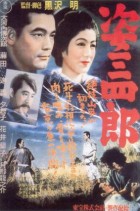 This September our online film club will focus on Kurosawa’s first film, Sanshiro Sugata (1943), and its sequel Sanshiro Sugata II (1945). We had something of a false start with the first one this May, before we decided to restart the club now that Criterion released their First Films of Akira Kurosawa box set. (For more information about the availability of these films, see here.)
This September our online film club will focus on Kurosawa’s first film, Sanshiro Sugata (1943), and its sequel Sanshiro Sugata II (1945). We had something of a false start with the first one this May, before we decided to restart the club now that Criterion released their First Films of Akira Kurosawa box set. (For more information about the availability of these films, see here.)
Since we already tried this once, we do not need to start from a blank slate. In fact, rather than writing a new introduction, I will point you to my earlier introduction to Sanshiro Sugata for some basic background reading. For pointers to some more in-depth background reading, there is always the regular Kurosawa books, which of course are not compulsory reading.
Back in May, our discussion centred on four topics, which you may also like to look at:
– The Jujitsu Teacher’s Daughter
– The Lotus, Truth and Beauty
– The Mother of Martial Arts Movies?
– A Movie-Like Movie
Feel free to add to those discussions! And of course, if you have something else in mind, your are very much encouraged to start new topics.
That should then cover Sanshiro Sugata. But what about Sanshiro Suhata II, which we will also be discussing this month?
To be honest, there is not all that much to be said. Kurosawa himself lacked any real interest in making the film, which Toho pressured him into doing following the success of the first one, and as Yoshimoto notes, “[i]t might be said that among Kurosawa’s works, this film is least satisfying artistically and perhaps most overtly propagandistic. Almost all the characters are cardboard figures, and if we still find some of them interesting, it is only because of our familiarity with Sanshiro Sugata, the original film.” (89) And as Prince notes, this cardboard like treatment extends also to the “flat visuals”: “Sanshiro Sugata, Part II exhibits a close conformity to Hollywood codes of continuity cutting and none of the radical violations of spatial perspective that typified the first film.” (55)
Most critics agree with these views. Richie in fact declares that “as a film, it is so very bad that its deficiencies will further explain the excellences of [Sanshiro Sugata]”, and that in it “we have what the original Sugata might have been had an ordinary director done it.” (24) As Richie goes on to point out, the sequel — which Yoshimoto suggest should perhaps rather be called a “remake” — is almost parody of the original, tracing the same characters, motifs and fights, but without the passion or the care.
All this is not to say that the film isn’t interesting. It does have its moments, and includes for instance the first case of Kurosawa’s use of Noh influences in his works. It is also a fairly straightforward propaganda picture in many places, so there should be plenty to discuss.
But speaking of propaganda films, on September 15 we will be introducing Kenji Mizoguchi’s The 47 Ronin (1941) into the mix. Copies are available at least from eBay and Amazon.
For the full schedule of our Film Club, see here.





